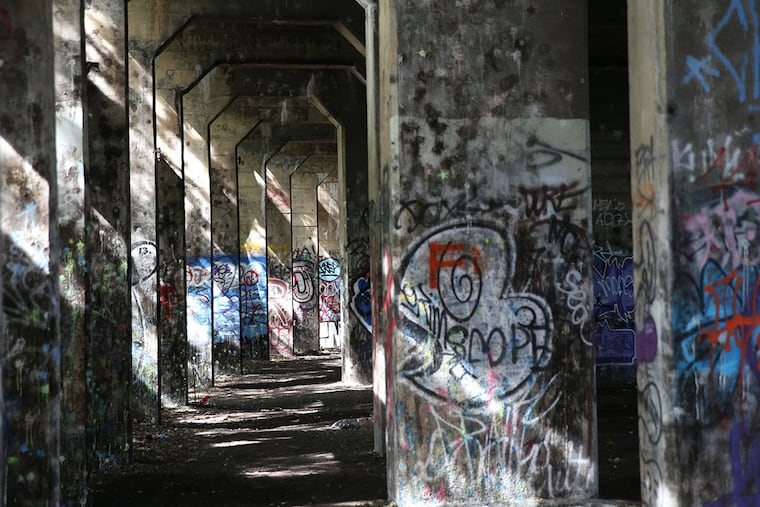‘Graffiti Pier’ deal to turn beloved Philly urban ruin into next park along Delaware River waterfront
The secluded industrial ruin is slated for conversion into the centerpiece of a new public park.

The no-trespassing signs may come down soon around the spray-paint-tagged urban dreamscape known as Graffiti Pier, with owner Conrail in a deal to sell the former coal dock and surrounding property for conversion into a park.
Under a recently signed contract, Conrail will sell six acres of its riverside tract in Port Richmond to the Delaware River Waterfront Corp. (DRWC), which will seek funding to connect the property to its growing network of trails and public gathering spaces in central Philadelphia’s eastern waterfront.
The sale points to a possible new life for the vacant property nearest the pier, a substantial departure from Conrail’s long-held view that the enclave’s future would resemble its industrial past.
“The property seems, at this point at least, a lot less likely to be developed for this purpose,” Jonathan Broder, Conrail’s vice president of corporate development and head lawyer, said before the deal’s planned announcement this week. “The market tells you something after a while, and this is something that the market is telling us right now.”
Pier 18, as Graffiti Pier is formally known, is part of a 200-acre property along the river from Allegheny Avenue to Cumberland Street that used to be the Reading Co.'s Port Richmond yard, part of the largest freshwater port facility in the world.
Starting in the late 1800s, the pier served as a transfer point for anthracite between Pennsylvania’s coal fields and the international market. But by the time Conrail absorbed the Reading Co. in 1976, coal was on the decline. The pier officially closed 15 years later.
While industrial operations have continued on northern sections of Conrail’s property, with users including a bulk-liquid storage depot, an asphalt plant, and a petroleum-products terminal, the section around Pier 18 near Cumberland Street was largely left alone.
Broder said that his company, which now manages rail networks jointly owned by CSX Transportation and the Norfolk Southern Railway, was for many years reluctant to advance any uses at the property that would limit industrial development, given the scarcity of rail-served industrial land so close to the city.
An adjacent strip of Conrail property flanking rail lines through Kensington, along Lehigh Avenue, was also left vacant and came to serve as a notorious encampment of heroin users until the rail company agreed to seal off the site in 2017 after cleaning it up.
Pier 18, meanwhile, was discovered by graffiti artists who turned its abandoned cement pillars into an ever-evolving canvas, thus drawing urban explorers to what eventually became an Instagram-ready forest of color and decay.
While officially off limits, the visits were tolerated until last year, when reports of theft and assault at and around the property prompted police to begin enforcing a no-trespassing ordinance, isolating the site from the public.
Conrail’s newly signed agreement with the DRWC, which manages development along central Philadelphia’s Delaware River waterfront, signals an end to that isolation, with the secluded industrial ruin now slated for conversion into the centerpiece of a park.
Under the deal, the rail company will sell a parcel that includes Pier 18 and a smaller pier to its immediate southwest, along with a property connecting those piers with streets to the northeast. A sale price was not disclosed.
The DRWC’s development of the property will begin with a planning study funded by the William Penn Foundation aimed at soliciting input from neighbors and others interested in how the site should be revamped. The discussion will help determine the future of the graffiti on the site.
“The overarching goals are further access to the riverfront, some sort of appealing public space, and some sort of preservation of the iconic nature of the pier,” DRWC president Joe Forkin said.
The deal hands the DRWC a new beachhead — nearly a mile north of Penn Treaty Park, currently the northernmost park under its purview — for the string of trails and public spaces it aims to have in place under a plan envisioning a park along every half-mile of a waterfront territory that extends into South Philadelphia.
The deal also puts the DRWC within striking distance of joining its trail to the one that begins a little over a mile to the north, continuing into Northeast Philadelphia, under the management of the nonprofit Riverfront North Partnership.
Conrail’s Broder said he sees the park plan as making his company’s section of the waterfront even more conducive to the residential development that’s been pushing into the area, such as the recently disclosed proposal for an apartment and townhouse complex on a former shipyard property near Pier 18.
“It has the impact of sort of catalyzing and sort of creating some steroids to help develop the rest of the property,” he said. “It’s really part of place-making.”